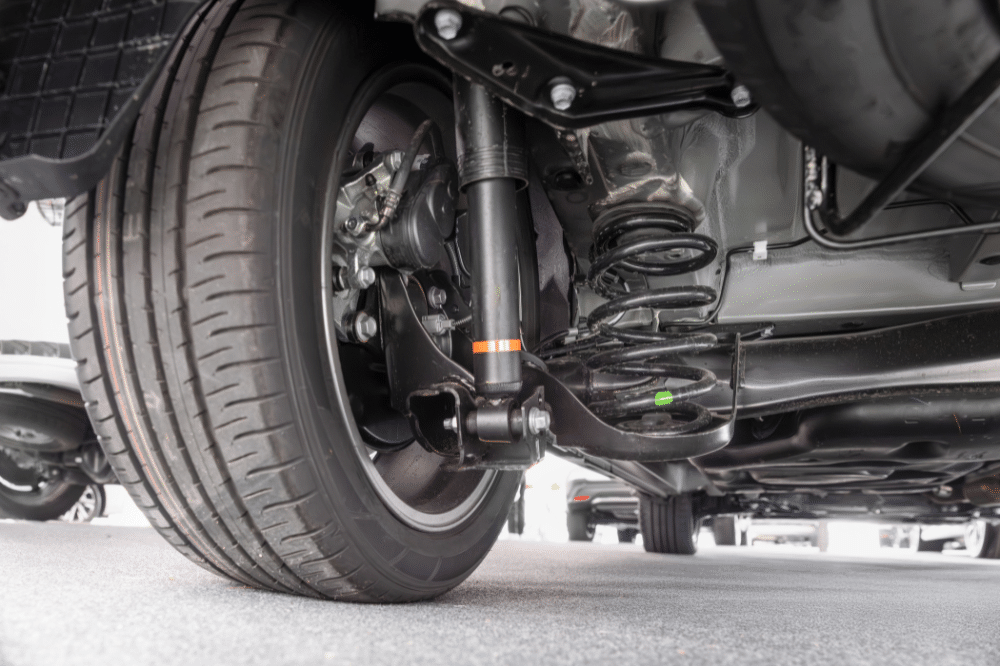TL;DR
If your car feels bumpy, pulls to one side, or wears through tires unevenly, it may be time for suspension repair. Sioux Empire Automotive Service Center in Tea, SD, inspects shocks, struts, ball joints, and alignments to restore comfort, safety, and control on Sioux Falls roads.
Noticing every crack, bump, or pothole during your drive through Tea or Sioux Falls? If your smooth ride now feels rough or unstable, your suspension may be worn out. At Sioux Empire Automotive Service Center, we often trace these symptoms back to failing shocks, struts, springs, or other critical suspension components.
Your suspension system does more than provide comfort. It keeps your tires connected to the road, absorbs impact from rough surfaces, and helps maintain control when braking or turning. When any part of that system starts to fail, the result is a ride that feels harsh, unsafe, and unpredictable.
Understanding Your Vehicle’s Suspension System
Many drivers think of the suspension as just “springs and shocks,” but it’s a complex network of components designed to work together. The main parts include:
- Shocks and struts – Hydraulic or gas-filled dampers that control the movement of your springs and keep your vehicle from bouncing excessively.
- Coil springs or leaf springs – Support the vehicle’s weight and help absorb road impacts.
- Control arms and ball joints – Connect your wheels to the frame while allowing up-and-down motion.
- Bushings – Cushions between metal parts to reduce vibration and noise.
- Steering linkage components – Help you direct your vehicle smoothly.
When all these parts are working properly, your vehicle feels solid, controlled, and comfortable. But if one or more wear out, the whole system suffers. That’s why even a single worn-out shock can make your entire car feel unstable.
Common Causes of a Bumpy Ride
A rough ride isn’t always caused by bad roads; often it’s a sign your suspension or wheels need attention. In the Sioux Falls and Tea, SD area, where potholes, construction zones, and rural roads are common, these problems can show up sooner than expected:
- Worn shocks or struts – Often the first suspension parts to wear out. When they lose effectiveness, you’ll feel every bump, and the vehicle may nose-dive when braking or sway in turns.
- Damaged springs – Support the vehicle’s weight and absorb larger impacts. Weak or broken springs can cause sagging, uneven handling, or a “floating” ride.
- Loose or worn bushings – Cushion metal suspension parts and reduce vibration. Worn bushings can lead to clunks, rattles, and increased steering wheel vibration.
- Tire and wheel problems – Unbalanced tires, bent rims, or uneven wear can mimic suspension trouble, creating vibrations and a harsh ride.
- Wheel alignment problems – Misalignment can cause pulling, uneven tire wear, and unstable handling, often from hitting potholes, curbs, or rough terrain.
Signs You May Need Suspension Repair
Knowing the warning signs of suspension trouble can help you address problems before they become safety hazards or lead to more expensive repairs.
1. Rough or Bumpy Ride
The most obvious sign is when your car no longer glides over the road. Instead, you feel every crack, pothole, or expansion joint. If your shocks or struts are worn, they lose their ability to absorb road impact. This doesn’t just make the ride uncomfortable; it also affects how well your tires stay connected to the pavement, which can compromise safety and handling.
2. Nose Dives or Rear-End Squats
When you brake and the front end of your car dips sharply, or when you accelerate and the back squats down, it’s a red flag. Healthy suspension should control the way weight shifts during these maneuvers. Worn struts or springs allow too much movement, which reduces stability and increases stopping distances. In emergencies, this can make a big difference in avoiding a collision.
3. Uneven Tire Wear
Your suspension system is designed to keep your tires firmly and evenly on the road. When parts like shocks, bushings, or control arms wear out, your tires can lose proper contact with the surface. This often leads to bald spots, cupping, or uneven tread wear. Not only does this shorten tire life, but it can also make your vehicle louder, less fuel-efficient, and harder to control in poor weather conditions.
4. Drifting or Pulling in Turns
If your vehicle leans excessively, drifts wide, or feels unstable when cornering, your suspension may not be holding the vehicle level. Worn shocks, struts, or bushings reduce stability, which can make it harder to stay in your lane on sharp turns or windy roads. In a growing area like Sioux Falls with plenty of highway curves and rural roads, this is more than an annoyance; it’s a safety risk.
5. Visible Damage or Leaks
Sometimes the signs are right in front of you. If you notice oily residue on your shocks or struts, it usually means the internal fluid has leaked out and they’re no longer functioning correctly. Broken or sagging springs, cracked bushings, or bent suspension components are also clear visual cues that it’s time for repair. Catching these early can prevent more expensive damage to related systems like steering and alignment.
Don’t ignore these warning signs. If your car feels bumpy or unstable, schedule a professional suspension inspection today. At Sioux Empire Automotive Service Center, our ASE-certified technicians can pinpoint the issue and get you safely back on the road. Call us directly at (605) 368-2815 or book your appointment online to get started.
Why Sioux Falls Roads Are Tough on Suspension
Local driving conditions in Tea, Sioux Falls, and the surrounding South Dakota area can be brutal on your vehicle’s suspension.
- Winter freeze-thaw cycles create potholes that can jar suspension parts loose.
- Construction detours often force drivers onto gravel or uneven surfaces.
- Seasonal road salt and moisture can contribute to corrosion on metal suspension components.
- Rural driving and hauling add stress from extra weight and uneven surfaces.
Even careful drivers will eventually face suspension wear due to these factors. That’s why regular inspections are so important.
How Sioux Empire Automotive Service Center Can Help
At Sioux Empire Automotive Service Center, we specialize in diagnosing and repairing all types of suspension issues, whether it’s a simple bushing replacement or a full set of new struts.
Here’s what sets our suspension service apart:
- Hunter Hawkeye Elite Alignment Machine – Ensures precise wheel alignment for better handling and tire life.
- Dealer-level diagnostic tools – We have factory scan tools for Ford, GM, and Chrysler vehicles.
- ASE-certified technicians – Skilled in both domestic and European makes like VW and Audi.
- 3-year/36,000-mile nationwide warranty – Peace of mind for every repair.
- Comfort and convenience – Free pickup/drop-off, loaner cars, and a waiting room with coffee, soda, popcorn, and Wi-Fi.
Our Suspension Repair Process
When you bring your vehicle to us for a bumpy ride or handling concern, here’s what you can expect:
- Consultation – We’ll ask questions about what you’ve noticed and when it happens.
- Test Drive – Our technicians will experience the symptoms first-hand.
- Comprehensive Inspection – We check shocks, struts, springs, bushings, control arms, and steering components for wear or damage.
- Alignment Check – Ensures proper tracking and tire wear.
- Digital Vehicle Inspection (DVI) – Photos and notes sent directly to you so you can see what we see.
- Clear Explanation and Estimate – No jargon, just honest recommendations and upfront pricing.
The Cost of Delaying Suspension Repairs
Driving with worn suspension parts isn’t just uncomfortable; it can quickly become a safety issue. When shocks, struts, or springs fail, your vehicle is no longer able to manage weight shifts and road impacts the way it should. This creates several problems that tend to snowball over time:
- Longer stopping distances – A weak suspension allows the front end to dip sharply during braking, reducing tire contact and increasing how far it takes to stop.
- Poor stability in emergencies – Whether swerving to avoid debris or making a sharp turn, a failing suspension makes the vehicle harder to control.
- Uneven tire wear – When tires don’t stay firmly planted on the road, they develop bald spots or cupping, which means premature replacement.
- Extra stress on other systems – Steering linkages, wheel bearings, and even brakes are forced to compensate, which can lead to additional failures and higher repair costs.
What might start as a single worn component can eventually affect the entire suspension and steering system. Delaying repairs often means a simple fix today turns into a much larger expense tomorrow.
Preventing Future Suspension Issues
While you can’t avoid normal wear and tear, you can extend the life of your suspension by:
- Avoiding potholes and rough roads when possible
- Not overloading your vehicle
- Getting regular suspension inspections (at least once a year)
- Replacing tires on time and keeping them properly inflated
- Having wheel alignments checked annually
How Often Should You Replace Shocks and Struts?
A common guideline is every 50,000–100,000 miles, but this depends heavily on driving conditions. If you frequently drive on rough roads, carry heavy loads, or tow, you may need replacements sooner. Our technicians can measure suspension performance and tell you exactly when it’s time.
FAQs About Suspension Repairs
How long can I drive with bad suspension?
You should not drive long with bad suspension, as worn shocks or struts reduce control, increase stopping distance, and make your vehicle unsafe. Even if the car still moves, the risk of accidents and damage to tires or steering components grows the longer repairs are delayed.
What’s the difference between shocks and struts?
The difference is that struts are a structural part of the suspension that support the vehicle’s weight, while shocks are separate dampers designed only to control spring and wheel movement. Most modern vehicles use struts in the front and shocks in the rear, though setups vary.
Can I replace just one shock or strut?
It’s not recommended to replace just one shock or strut, because the uneven performance can cause handling and stability issues. For proper balance and safety, suspension repairs are typically done in pairs, both front or both rear, so the components wear evenly.
Will suspension repair fix my steering pull?
Suspension repair can fix a steering pull if the issue is caused by worn components, poor alignment, or uneven tire contact. However, other problems like brake drag or tire pressure differences can also cause pulling, so a full inspection is the best way to identify the exact cause.
Key Takeaway
Your suspension is more than comfort — it’s critical for safety and handling. Addressing issues early saves money on tires and prevents dangerous driving conditions. Trust Sioux Empire Automotive Service Center in Tea, SD, for precise suspension repair backed by ASE-certified technicians and a 3-year/36,000-mile warranty.
Schedule Your Suspension Repair in Tea, SD Today!
A smooth ride is more than just comfort it reflects the health of your suspension, your vehicle’s safety, and the lifespan of your tires. If your car has started to feel rough, it’s a clear sign that something in the suspension needs attention.
At Sioux Empire Automotive Service Center, we provide trusted suspension inspections and repairs to keep your vehicle safe and reliable. Call us today at (605) 368-2815 or schedule your appointment online. You’ll find us at 46960 271st St, Tea, SD 57064, proudly serving drivers in Tea, Sioux Falls, and surrounding communities with honest, high-quality suspension repairs backed by our industry-leading warranty.


